HOME|Ideas and resoueces for planetary science experiments|Daily motion of the sun --- Part2
宇宙の実験教室
Ideas and resoueces for planetary science experiments
カテゴリ
Category
- 実験教室Idea and Resources for Space science experiments
- 対象項目別Category: Contents
- 学年単元別Category: Study Age
-
- 実践授業Activity Reports
タグ
Tag
 太陽の日周運動 その2
太陽の日周運動 その2
ねらい
観察する場所の緯度によって太陽の動き方が変わることを理解し よう。
地球のどこにいても、太陽の天球上の動きは日本で観察できるのと同じでしょうか。太陽の日周運動 その1では、日本における太陽の動きを観察しました。それでは、ロン ドンでも日本と同じように太陽は動いているのでしょうか。
ロンドンにおいて、全天カメラで撮影した太陽の1日の動きの映像を観察し、ワーク シートや透明半球に太陽の動く道すじをプ ロットしてみましょう。
ロンドンは、北緯51度にある都市です。日本の仙台に比べて約15度緯度が高くなります。観察する位置によらず、太陽の道すじは一年中 同じでしょうか。
季節によって太陽の出ている昼の長さと夜の長さは違います。北極圏では、白夜があることも知られています。様々な地域の太陽の動く道す じを、さまざまな季節 で比較してみましょう。そして、各地域の季節による昼と夜の長さの違いを考えてみましょう。
ロンドンと日本の位置
ロンドンと日本の緯度を地図で確かめよう。
ロンドンは北緯51度、日本の仙台は、北緯38度です。地球の自転軸は、太陽の周りを回る公転面に対して、約23度傾いています。各地 面に太陽光があたる角度も、時間だけでなくその地域の緯度によって異なります。どのように異なるのでしょうか。
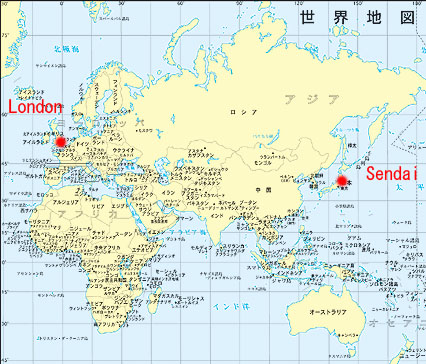
全天カメラとは
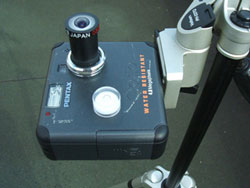 |
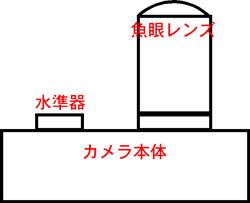 |
全天カメラ全体像 |
横から見た模式図 |
全天カメラシステムは、撮像カメラ(デジタルカメラ)・魚眼レンズ・水準器から構成されています。
魚眼レンズは視野が180度あるので、魚眼レンズを付けたカメラを天頂に向けて撮影すると、カメラを設置した場所から見た空全体の風景をひとつの写真に撮 ることができます。
魚眼レンズの見え方
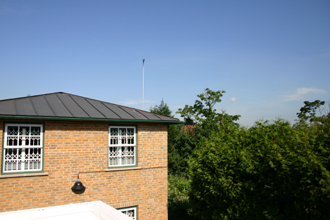 |
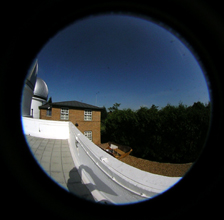 |
普通のレンズで撮った写真 |
同じ場所で魚眼レンズで撮った写真 |
ムービーはどうやって作るの?
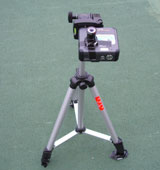 全天カメラシステムを使って、日の出から日没まで一定時間ごとに空全体の写真を撮ります。こうして撮影した画像データをパ ソコンに取り込み、Adobe社のグラフィックソフトのイラストレーターを使って方角や画像の調整、方位・高度座標の挿入をします。さらに、 Microsoft社の動画編集用ソフトMovie Makerを用いて、各画像を時間の経過と共に編集し映像化します。
全天カメラシステムを使って、日の出から日没まで一定時間ごとに空全体の写真を撮ります。こうして撮影した画像データをパ ソコンに取り込み、Adobe社のグラフィックソフトのイラストレーターを使って方角や画像の調整、方位・高度座標の挿入をします。さらに、 Microsoft社の動画編集用ソフトMovie Makerを用いて、各画像を時間の経過と共に編集し映像化します。
実験方法
用意するもの
日周運動のムービー、2時間おきの映像、ワークシート(これらのファイルはダウンロードできます)、パソコン、映像を見るためのアプリ ケーション
ムービーを見よう
ムービーを見て、太陽がどちらからどちらへ動いているか、大まかな道すじを確認しましょう。
2時間おきの太陽の位置を記録しよう
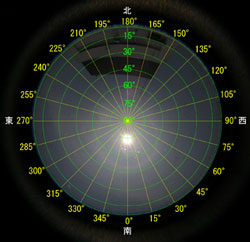
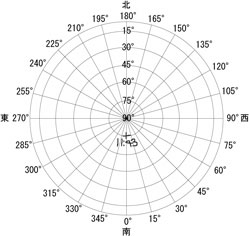
次に、2時間おきの映像を見て太陽の位置を読みとり、ワークシート上にプロットしましょう。
左の写真は宮教大(仙台市北緯38度)で2005年6月21日の南中時の画像です。 淡く白い円形が太陽です。この映像から、方位・高度を読みとってワークシートに記入したものが右の図です。
同様に、2時間おきの画像から、ワークシートに太陽の1日の道すじを記録しましょう。
ロンドンと日本の同じ季節の太陽の道すじも記録しよう
ロンドンと日本の同じ季節の2時間おきの画像から太陽の位置を読みとり、ワークシートに太陽の1日の道すじを記録しましょう。太陽の高 度、日の・出日の入りの位置は同じでしょうか。
観察結果
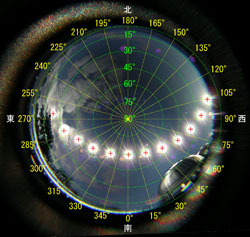 |
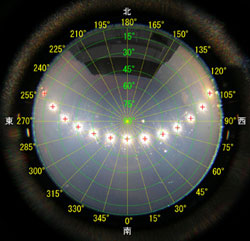 |
夏至の頃の太陽の動きを異なる場所で観察しました。左はロンドン大学天文台(北緯51度36.8分、東経14.4分、高度81m)で撮 影した2005年7月12日の太陽の動きです。右は、仙台市(宮教大屋上北緯38度)で撮影された2005年6月21日の太陽の動きです。各地点の日周運 動を見 て、1日の太陽の動いた道すじをワークシートに記入てみましょう。
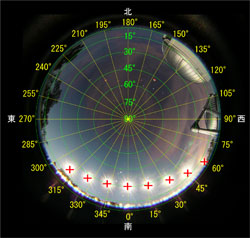 |
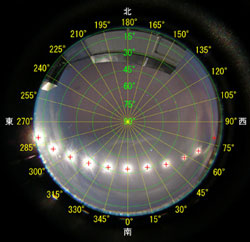 |
左はロンドン大学天文台(北緯51度36.8分、東経14.4分、高度81m)で撮影した2005年10月10日の太陽の動き、右は、 仙台市(宮教大屋上北緯38度)で撮影された2005年3月15日の太陽の動きです。各地点のそれぞれの季節の日周運動を見 て、1日の太陽の動いた道すじをワークシートに記入てみましょう。
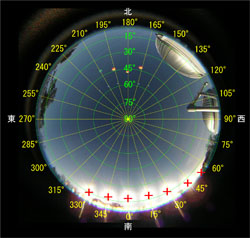 |
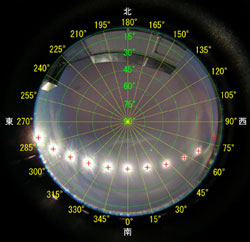 |
夏至の頃の太陽の動きを異なる場所で観察しました。左はロ ンドン大学天文台(北緯51度36.8分、東経14.4分、高度81m)で撮影した2005年11月18日の太陽の動きです。右は、仙台市(宮教大屋上北 緯38度)で撮影された2005年x月xx日の太陽の動きです。各地点の日周運動を見 て、1日の太陽の動いた道すじをワークシートに記入てみましょう。
比べてみよう-1
記録した太陽の道すじを同じ地点のそれぞれの季節で比べてみましょう。
南中高度、日の出の位置、日の入りの位置、昼の長さなど、どのようにちがいますか。
比べてみよう-2
同じ季節でロンドンの太陽の動きと日本における 太陽の動きをと比較してみましょう。南中高度、日の出・日の入りの位置、時間、昼の長さに違いはあるでしょうか。
観察のまとめ
- 太陽は東からのぼり、南の空を通って、西に沈んでいくように見える。
- 夏の太陽の南中高度は冬より高い。
- 夏の日の出と日の入りの位置は冬の位置より北よりになる。
- 夏の昼の長さは冬より長い。
ロンドンと日本と比較してみて
- ロンドンの方が緯度が高い位置にあります。
- 太陽の南中高度は、同じ季節では、ロンドンの方が低くなります。
- ロンドンの冬至の頃は、朝8時頃に太陽が出て午後3時頃には太陽が沈みます。
- 逆にロンドンの夏至の頃は、夜10時頃まで空が明るいです。
観察してわかったことをまとめましょう。
ロンドンの太陽の運動の季節の変化について
考えよう
このように、地球上の位置や季節によって太陽の南中高度や昼の長さにちがいが生じるのはどうしてでしょうか。
宇宙から見た地球と太陽の位置関係から天球上の太陽の動きを考え、その理由を探ってみましょう。
ダウンロード
| ロン ドン大学天文台(北緯51度36.8分、東経14.4分、高度81m)撮影 日周運動ムービー・定時間おきの画像 | ||
| 夏至付近 2005年7月12日 出03:56 南中12:05 没20:13
|
||
 |
||
| 秋分付近 2005年10月10日 出06:15 南中11:46 没17:16 | ||
 |
||
| 冬至付近 2005年11月18日 出07:23 南中11:44 没16:05 | ||
 |
||
| ワークシート | ||
| 関係論文 | ||
教室で行う宇宙の実験‐7: 全天カメラを用いた太陽の日周運動の映像教材の開発 高田淑子 千島拓朗 et al. |
||
 Daily motion of the sun --- Part2
Daily motion of the sun --- Part2
Introduction
Path of the daily motion of the sun changes with latitudes.
Do you think the path of the daily motion of the sun is the same anywhere in the earth?
Does the sun move just like we have observed from Japan on Daily motion of the sun Part1?
Watch the movie of daily motion of the sun that was taken in London with a digital camera with a 180-degree field of vision lens and plot the path on a worksheet or a clear plastic hemisphere.
London is located at Latitude 51°N. It is about 15 degrees higher than Sendai, Japan. Is the path the same all year long at any latitudes?
Length of day and night changes with seasons. Also, at the Arctic, midnight sun is observed around midsummer. Compare the paths of several seasons from several latitude locations.Think of the difference in length of day and night in different seasons and locations from the results.
The locations of London and Japan
The locations of London and Japan
London is located at Latitude 51°N. Sendai, Japan is at Latitude 38°N. The earth's axis is tilted at 23.4 degree to it's orbit plane. The angle between ground and sun ray changes depending on not only season or time but also latitude. Let's check how it changes.
 e
e
The whole sky camera
 |
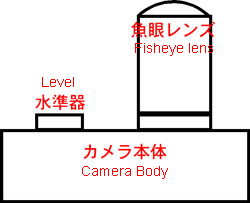 |
Over view image of the Whole Sky Camera |
Pattern diagram seen from side |
The Whole Sky Camera system is composed of the digital camera, the fisheye lens, and the a level.
Because the fish-eye lens has 180-degree field of view, Whole sky scenery from the place where the camera was set up can be taken in one photograph by turning the camera with the fish-eye lens to the zenith.
The view through the fisheye lens
 |
 |
A picture taken by normal lens |
A picture taken by fisheye lens at the same place |
How are the movies made?
 From sunrise to sunset, a whole sky photograph is taken at regular intervals by the Whole Sky Camera system. This image data is downloaded onto a computer, the directions and the images are processed, and coordinates of direction and altitude are added to them using Adobe graphic soft Illustrator. Moreover, each image is edited with the passage of time to make movies by using the software Movie Maker to edit Microsoft-based animations.
From sunrise to sunset, a whole sky photograph is taken at regular intervals by the Whole Sky Camera system. This image data is downloaded onto a computer, the directions and the images are processed, and coordinates of direction and altitude are added to them using Adobe graphic soft Illustrator. Moreover, each image is edited with the passage of time to make movies by using the software Movie Maker to edit Microsoft-based animations.
Experimental Method
Things to prepare
The movies of daily motion of the sun, taken at two hour intervals, Worksheet ( You can download them.), PC, Application for seeing movies
※If you have any chance to make a movie of daily motion of the sun at school that contains landscape with which you are familiar, that is the best one.
Let's watch the movie!
Watch the movie and check out the path of the sun. From where to where is it moving?
Record the position of the sun at two hour intervals.


Next, watch the movie, note the position of the sun at each two hour interval and plot it on your worksheet.
The left is one of the images in the movie of daily motion of the sun taken at 11:43 a.m. (Culmination) on June 21, 2005 at Sendai Japan (latitude 38 degrees north).A light white circle is the sun. The right diagram is the worksheet with the position of the sun plotted by reading the direction and the altitude of it from the left image.
In the same way, record the path of the sun over a whole day in your worksheet by watching the image every two hours.
Record the path of the sun in London and Japan.
Watch another movie taken in London and find out if there are any differences between the locations (latitudes).
In the same way, read the position of the sun from the images every two hours and record the path of the sun during a day.
Experimental Result
The path of the sun on summer solstice in London and Japan.
 |
 |
The left picture is the path of the sun, which was taken on July 12, 2005 at University of London Observatory (Latitude 51.61 degrees north, longitude 0.24 degrees east, 81 meters high). The right picture is the path of the sun, which was taken on June 21, 2005 at Miyagi University of Education, Sendai, Japan (Latitude 38 degrees north) Record the path of the sun over a whole day in your worksheet by watching the both movies.
 |
 |
The left picture is the path of the sun, which was taken on July 12, 2005 at University of London Observatory (Latitude 51.61 degrees north, longitude 0.24 degrees east, 81 meters high). The right picture is the path of the sun, which was taken on June 21, 2005 at Miyagi University of Education, Sendai, Japan (Latitude 38 degrees north) Record the path of the sun over a whole day in your worksheet by watching the both movies
The path of the sun on equinox in London and Japan.
 |
 |
The left picture is the path of the sun, which was taken on October 10, 2005 at University of London Observatory (Latitude 51.61 degrees north, longitude 0.24 degrees east, 81 meters high). The right picture is the path of the sun, which was taken on March 15, 2005 at Miyagi University of Education, Sendai, Japan (Latitude 38 degrees north) Record the path of the sun over a whole day in your worksheet by watching the both movies.
Let's Compare them.---1
Compare the paths of the sun that recorded in different seasons in the same place.
Can you find out the differences between them in Culmination altitude, position of sunrise, position of sunset and length of daytime? How different are they?
Let's Compare them.---2
Compare the paths of the sun that recorded in London and Japan in the same season.
Can you find out the differences between them in Culmination altitude, position of sunrise, position of sunset and length of daytime? How different are they?
Practical Description
Describe what you understood from the observation.
The path of the sun in London in seasons
- The sun rises in the east and sets in the west reaching its highest point in the south.
- The culmination altitude in summer is higher than winter.
- The position of sunrise and sunset in summer becomes more northern than winter.
- Daytime in summer is longer than winter.
Comparing the path of the sun in London with Japan
- London is located higher latitude than Japan.
- The culmination altitude in London is lower than the one in Japan in the same season.
- The sun rises at about 8:00 a.m. and sets at about 3:00 p.m. in London around winter solstice.
- It doesn't get dark until around 10:00 p.m. in London around summer solstice.
Discussion
Why do the culmination altitude or length of day change with seasons?
To find out the answer, imagine the motion of the sun in the Celestial Sphere that shows the position of the earth and the sun from the universe.
Download
| Movie of Daily Motion of the Sun taken at University of London Observatory (Latitude 51.61 degrees north, longitude 0.24 degrees east, 81 meters high) / Every hours | ||
| Around Summer Solstice July 12, 2005 sunrise 03:56 culmination 12:05 sunset 20:13 |
||
 |
||
| Around Autumnal Equinox October 10, 2005 sunrise 06:15 culmination 11:46 sunset 17:16 | ||
 |
||
| Around Winter Solstice November 18, 2005 sunrise 07:23 culmination 11:44 sunset 16:05 | ||
 |
||
| Worksheet | ||
| Related paper | ||
Space experiments in classrooms-7: Development of movies of solar diurnal motion imaged by solar camera |
||











